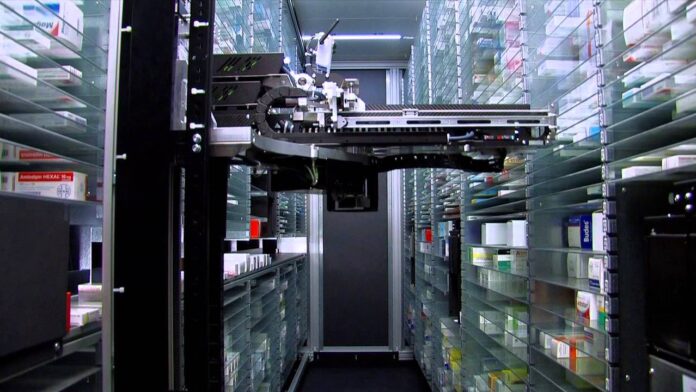Asia Pacific pharmacy automation market is growing at a high CAGR because of increasing incidences of chronic and acute wounds, which is driving the Asia Pacific Pharmacy Automation market. The pharmacy automation system market is primarily driven by socioeconomic reasons such as increasing acceptance and demand for automated solutions in pharmacies and increasing cases of disease due to the aging population. These automated technologies allow physicians to focus on direct patient care by streamlining pharmacy processes and reducing the risk of error. Product development and rising hospitalization rates are secondary growth drivers. Hospitals can use pharmacy automation systems to track and manage medications, supplies, and patient health information to ensure only the products they need are replenished.
A recent study conducted by the strategic consulting and market research firm, BlueWeave Consulting, revealed that the Asia Pacific pharmacy automation market was worth USD 422.1 million in the year 2021. The market is projected to grow at a CAGR of 9.2%, earning revenues of around USD 778.1 million by the end of 2028. The Asia Pacific Pharmacy Automation market is booming because of the rapid decentralization of pharmacies, increasing adoption of automated delivery systems for the elderly, and increased investment in healthcare infrastructure development. However, the growth of this market is restrained by strict regulations that delay product launches.
Increasing geriatric population in Asia to accelerate demand
The elderly population is increasing all over the world. As a result, the number of life-threatening chronic diseases is rising, and so is the number of prescriptions. The demand for pharmacy automation is increasing to decrease medication errors while dispensing or refilling and to keep huge prescription records. According to a World Health Organization (WHO) report in Oct 2021, between 2015 and 2050, the proportion of the world population aged 60 and over will nearly double from 12% to 22%. A report of UNFPA Asia Pacific stated that by 2050, one in four people in the Asia Pacific region would be over the age of 60. The region’s elderly (over 60) population will triple between 2010 and 2050, reaching almost 1.3 billion. Such statistics and new product launches are expected to further escalate the market growth in the Asia Pacific region.
Sample Report @ https://www.blueweaveconsulting.com/report/asia-pacific-pharmacy-automation-market/report-sample
Impatient Pharmacies having the Largest Market Share in 2021 –by End User
Based on end-user, the Asia Pacific pharmacy automation market is segmented into Retail Pharmacies, Outpatient Pharmacies, and Impatient Pharmacies. The Impatient pharmacy segment is expected to dominate the pharmacy automation market due to the use of automated dispensing cabinets, automated drug storage, and barcoded unit dose packaging systems, which are increasing to improve production and efficiency. The hospital offers pre-and post-operative procedures and has a large pharmacy to support these processes. Pharmacy automation should reduce errors and save hospital resources. Therefore, inpatient pharmacies dominate the market in the long run.
Regional Insights
On the national side, markets are analyzed in China, India, Japan, South Korea, Australia, Thailand, Malaysia, Indonesia, Vietnam, Philippines, and the rest of Asia Pacific. China is expected to register the highest growth during the forecast period. This is due to increasing initiatives to improve the country’s healthcare infrastructure, minimize medication errors, and a growing elderly population in China.
India is one of the fastest growing countries with huge potential for the pharmacy automation equipment market. This growth is due to the rising position of Indian companies in the global market. Another factor supporting market growth is the huge population base in need of better healthcare. A surge in demand for healthcare facilities caused by the large population base is pushing the government to launch new initiatives. Additionally, the government is investing heavily in improving the overall healthcare infrastructure.
Impact of COVID–19 on Asia Pacific Pharmacy Automation Market
Governments in several Asian countries have imposed widespread restrictions, such as national blockades, to limit the spread of the COVID–19 infection that impacted the healthcare market in both developed and developing countries. Automated systems offer excessive cost efficiency and safety benefits, streamlining pharmacy types by improving data workflows. In addition, increasing infection rates are driving demand for medicines, creating a need for automated drug delivery systems. Therefore, medical facilities and pharmacies prefer these automation systems, driving the growth of the pharmacy automation market in the Asia Pacific region.
Competitive Landscape
Key players operating in the Asia Pacific pharmacy automation market are Becton, Dickinson and Company, Yuyama, Omnicell Inc, KUKA AG, Tosho Co Inc, Cerner Corporation, TouchPoint Medical Solutions, Takazono Corporation, Capsa Healthcare, Arxium Inc, and other prominent Players. These companies use new product development, merger acquisitions, in–house R & D, and new partnerships to grow their businesses, especially in promising emerging markets.
The in–depth analysis of the report provides information about growth potential, upcoming trends, and statistics of the Asia Pacific pharmacy automation market. It also highlights the factors driving forecasts of total market size. The report promises to provide recent technology trends in the Asia Pacific pharmacy automation Market and industry insights to help decision–makers make sound strategic decisions. Furthermore, the report also analyzes the growth drivers, challenges, and competitive dynamics of the market.
Contact Us:
BlueWeave Research Blog
Phone No: +1 866 658 6826
Email: info@blueweaveconsulting.com














